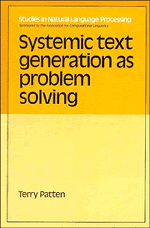Book contents
- Frontmatter
- Contents
- Dedication
- Preface
- 1 Introduction
- 2 Background I: AI problem solving
- 3 Background II: systemic grammar
- 4 The conflation
- 5 The formal model
- 6 The implementation
- 7 Related work in text generation
- 8 Conclusions
- Appendix A OPS5 tutorial
- Appendix B Sample texts
- Appendix C Excerpts from the grammar
- Notes
- Bibliography
- Index
7 - Related work in text generation
Published online by Cambridge University Press: 26 March 2010
- Frontmatter
- Contents
- Dedication
- Preface
- 1 Introduction
- 2 Background I: AI problem solving
- 3 Background II: systemic grammar
- 4 The conflation
- 5 The formal model
- 6 The implementation
- 7 Related work in text generation
- 8 Conclusions
- Appendix A OPS5 tutorial
- Appendix B Sample texts
- Appendix C Excerpts from the grammar
- Notes
- Bibliography
- Index
Summary
This chapter will compare and contrast the text-generation method described in the previous chapters with other recent work in the field. This will not include the large body of research done recently on discourse planning, but only work concerned with realizing these plans. The most notable exclusion on these grounds is McKeown's TEXT (McKeown, 1982, 1983, 1985) which sets some discourse-related goals then does the actual text generation using unguided search and backtracking (see Appelt, 1983, p. 599).
A look at recent systems reveals that there are currently two general approaches to text generation: the “grammar-oriented” approach and the “goaloriented” approach. Both of these will be outlined, including their major practitioners, and the advantages that are offered.
Next, the systems that try to combine these two approaches will be considered. It will be shown that SLANG successfully achieves this, capturing the advantages of both the grammar-oriented and goal-oriented approaches.
The grammar-oriented approach
Several of the major text-generation projects are “grammar-oriented.” This term will be used to refer to those systems that traverse an explicit linguistic grammar. Since the flow of control is directed by the grammar traversal, the logical structure of the system reflects the structure of the grammar.
The original grammar-oriented systems would simply traverse the grammar, typically an ATN, backtracking where necessary. More recent grammar-oriented systems avoid backing up by doing an analysis at choice points to make sure the right decision is made the first time. This analysis often involves considering semantic and pragmatic issues that, for reasons of modularity, should not be directly accessible to the grammar.
Information
- Type
- Chapter
- Information
- Systemic Text Generation as Problem Solving , pp. 133 - 145Publisher: Cambridge University PressPrint publication year: 1988
